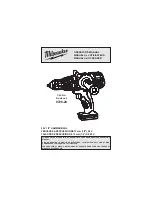
9 ENGLISH
Electronic function
The tool is equipped with the electronic functions for
easy operation.
•
Active Feedback sensing Technology
If the tool is swung at the predetermined accelera-
tion during operation, the motor is forcibly stopped
to reduce the burden on the wrist.
NOTICE:
Hold the tool firmly while operating.
NOTICE:
If any malfunction occurred with the
electronic function, the light blinks for 3 seconds,
and then, turns off. In that case, contact with Makita
Authorized or Factory Service Centers to repair.
NOTE:
This function does not work if the acceleration
does not reach the predetermined one when the tool
is swung.
NOTE:
If the tool is forcibly stopped, release the
switch trigger, and then pull the switch trigger to
restart the tool.
ASSEMBLY
CAUTION:
Always be sure that the tool is
switched off and the battery cartridge is removed
before carrying out any work on the tool.
Installing side grip (auxiliary handle)
►
Fig.9:
1.
Side grip
2.
Protrusion
3.
Groove
4.
Arm
Always use the side grip to ensure operating safety.
Install the side grip so that the protrusions on the arm fit
in the grooves on the tool barrel. Turn the grip clockwise
to secure it. The grip can be fixed at desired angle.
Installing or removing driver bit/drill bit
►
Fig.10:
1.
Sleeve
2.
Close
3.
Open
Turn the sleeve counterclockwise to open the chuck jaws.
Place the driver bit/drill bit in the chuck as far as it will go.
Turn the sleeve clockwise to tighten the chuck. To remove
the driver bit/drill bit, turn the sleeve counterclockwise.
Installing hook
CAUTION:
When installing the hook, always
secure it with the screw firmly.
If not, the hook
may come off from the tool and result in the personal
injury.
CAUTION:
Use the hanging/mounting parts
for their intended purposes only.
Using for unin-
tended purpose may cause accident or personal
injury.
►
Fig.11:
1.
Groove
2.
Hook
3.
Screw
The hook is convenient for temporarily hanging the tool.
This can be installed on either side of the tool. To install
the hook, insert it into a groove in the tool housing on
either side and then secure it with a screw. To remove,
loosen the screw and then take it out.
Installing driver bit holder
Optional accessory
►
Fig.12:
1.
Driver bit holder
2.
Driver bit
Fit the driver bit holder into the protrusion at the tool foot
on either right or left side and secure it with a screw.
When not using the driver bit, keep it in the driver bit hold-
ers. Driver bits 45 mm-long (1-3/4") can be kept there.
OPERATION
CAUTION:
When the speed comes down
extremely, reduce the load or stop the tool to
avoid the tool damage.
Hold the tool firmly with one hand on the grip and the
other hand on the handle to control the twisting action.
►
Fig.13
NOTICE:
Do not cover vents, or it may cause over
-
heating and damage to the tool.
►
Fig.14:
1.
Vent
Screwdriving operation
NOTICE:
Adjust the dial to the proper torque level
for your work.
NOTICE:
Make sure that the driver bit is inserted
straight in the screw head, or the screw and/or driver
bit may be damaged.
First, align
marking with the arrow on the tool body
and adjust the torque level.
Place the point of the driver bit in the screw head and apply pres
-
sure to the tool. Start the tool slowly and then increase the speed
gradually. Release the switch trigger as soon as the tool stops the
rotation automatically and the green light turns on for 5 seconds.
NOTE:
When driving wood screw, pre-drill a pilot hole
2/3 the diameter of the screw. It makes driving easier
and prevents splitting of the workpiece.
NOTE:
In a cold environment, the tool may stop at
lower torque level depending on circumstances.
Drilling operation
First, turn the action mode changing ring so that the arrow
points to the
marking. Then proceed as follows.
Drilling in wood
When drilling in wood, the best results are obtained with
wood drills equipped with a guide screw. The guide screw
makes drilling easier by pulling the drill bit into the workpiece.
Drilling in metal
To prevent the drill bit from slipping when starting a
hole, make an indentation with a center-punch and
hammer at the point to be drilled. Place the point of the
drill bit in the indentation and start drilling.
Use a cutting lubricant when drilling metals. The excep-
tions are iron and brass which should be drilled dry.










































